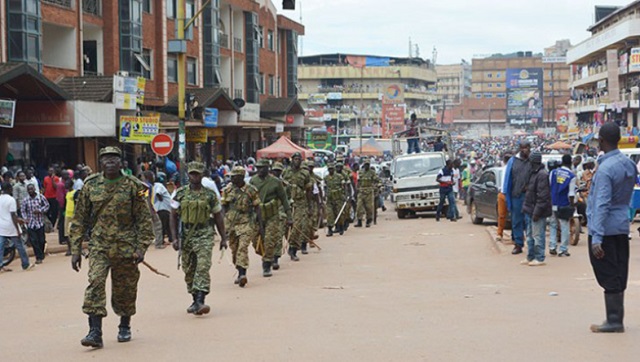
Museveni frustration
The news headlines are all screaming of a crime wave. Oct.22: Three shot dead in Lyantonde. Boy beheaded, house-help on the run. Sept.06: Two people, a man and a woman are found dead from gunshot wounds along the Kampala-Entebbe Express Highway at Nambigirwa Bridge, near Mpala in the Katabi Town Council area. An AK47 rifle belonging to Constable Davis Taremwa of the Uganda Police is found in the car. The dead were later identified as Joshua Nteireho Rushegera and Mellina Tumukunde.
Aug.28: A woman and man are found dead in Nakitutulu, Nama sub-county, Mukono district. They are later identified as Maria Nagirinya, a social worker and her driver Ronald Kitayimbwa. They are believed to have been kidnapped and murdered. July 30: Body of man suspected to have been murdered is discovered hanging in Katwe Lufula Zone.
Reading the headlines, influential voices are speaking out.
“Criminal gangs are all over the country. People have been traumatized,” said the outgoing Archbishop of the Church of Uganda, Rt. Rev. Stanley Ntagali on Oct. 20 during a farewell church service at Bishop West Boarding School in Mukono. He mentioned robberies, murders, and iron bar hit-men.
Museveni’s move smirked of frustration over such views. But since when did sensitive security assignments become a matter of public discussion? The President was clearly piling on pressure and, as he often does, politicking. He possibly wanted an angry, restless, and fearful public to have a target to blame. In that sense, this assignment could spell either praise or perdition for Sabiiti; and inevitably Ochola. It all depends on how they handle the assignment. And the fumble is on.
A security analyst who spoke to The Independent, however, said Sabiiti should not be driven by crowd emotions but look at the numbers and patterns of crime to make decisions. The analyst said the fear of crime expressed by the public is far bigger than the actual crime rate.
“Sabiiti should call a press conference every week and release crime statistics,” the analyst said, insisting that the public would easily see that although crime is highlighted more in the media these days, especially if a known person is involved, the crime rates are either stable or declining.
When The Independent looked at the latest statistics, from the Uganda Police Annual Crime Report 2018, it showed the lowest crime rate in the last four years to have been recorded last year. It showed that 612 crimes were committed per 100,000 people compared to a crime rate of 667 in 2017, that of 666 in 2016, and 742 in 2015.
Yet, according to public perception, last year witnessed unprecedented levels of crime. This view is based on the high profile kidnap in February 2018 of Susan Magara, and the murders of then-Arua Municipality MP Ibrahim Abiriga in June 2018, Muhammad Kirumira in September, and other less known figures.
The statistics reveal that what the public perceives is sometimes not the actual. Little known Kaabong district had the highest murders by shooting in 2018 at 12, according to the police report, followed by Kalungu 10, and Arua 7. Among the policing regions, Kampala North led with 20 murders by shooting.This police region extends beyond Kampala District and covers Kakiri, Kasangati, Kawempe, Nansana, Old Kampala, Wakiso, and Wandegeya. It was followed at 19 murders by shooting in the Greater Masaka police region which covers Bukomansimbi, Kalangala, Kalungu, Lwengo, Lyantonde, Masaka, and Rakai.
According to the police report, the volume of crimes declined in 2018 by 5.2% to 238,746 cases registered, compared to 252,065 cases registered in 2017. And the highest number of killings did not happen in Kampala but in Mbarara (138), Arua (106), Ntungamo (96), and Mubende (84). Looking at these figures, the security analyst said the increasing fear of crime and insecurity in the country can best be calmed through communication.
Sabiiti’s policing strategy
Sabiiti’s policing philosophy is not clear yet. His elevation to the second top-most rank in police appears driven more by his belonging to the inner core of Museveni’s military machine as a close relative than to core policing ability. His father, the late Zekeriah Magyenyi was a bush war veteran related to Museveni through marriage. Sabiiti spent only one year as head of the UPDF Military Police. Before that he had been deputy head of Museveni’s elite protection force, the Special Forces Command (SFC). But reports from people who know him say Sabiiti is a brainy biochemist who thrives on challenge. He reportedly was an A-student at university and likes to excel at tasks. He has also had training in Russia.
When he spoke to journalists on Oct. 18, he appeared to instinctively touch on what smart policing requires; getting public involvement in policing and fighting crime.
“The plan will work well once we work well with the public,” he said.
But Sabiiti’s idea of involving the public is to establish suggestion boxes to gather information from the public in confidence and his new idea was profiling of repeat offenders.
The plan he unveiled showed little creativity. It was more of the problem oriented type, favouring heavy enforcement instead of cooperation. It followed the traditional policing route; of preventive foot and motorized patrols, rapid responses and is incident driven – responding to distress calls. But Rapid Response Units, 24/7 police hotlines and emergency numbers are what have been used all along.
According to policing experts, they are ineffective and costly, especially if the police are in vehicles. They only catch criminals if they happen to drive into them, or are called and respond while a crime is progress.
“Random patrol only leads to random results,” is what one expert said.
Sabiiti’s plan reads like a hotchpotch of the usual policing methods that have either been talked about and not been implemented or have been implemented and failed to yield good results. Some are quite long term; such as increased collaboration between the police and judicial officers, completion of installation of Closed Circuit Television (CCTV) cameras in Kampala, Wakiso, and Mukono districts, and enforced re-registration of residents by area LC officials.
According to many commentators, including retired former police top brass and individuals knowledgeable about police work, Sabiiti’s plan failed to address the most critical steps needed for police to effectively fight crime.
 The Independent Uganda: You get the Truth we Pay the Price
The Independent Uganda: You get the Truth we Pay the Price


